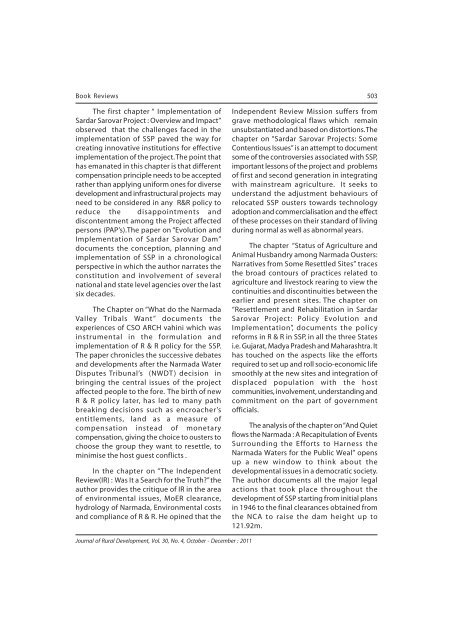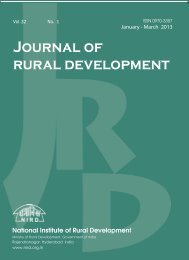Issue for October - December 2011 - National Institute of Rural ...
Issue for October - December 2011 - National Institute of Rural ...
Issue for October - December 2011 - National Institute of Rural ...
Create successful ePaper yourself
Turn your PDF publications into a flip-book with our unique Google optimized e-Paper software.
Book Reviews 503The first chapter “ Implementation <strong>of</strong>Sardar Sarovar Project : Overview and Impact”observed that the challenges faced in theimplementation <strong>of</strong> SSP paved the way <strong>for</strong>creating innovative institutions <strong>for</strong> effectiveimplementation <strong>of</strong> the project. The point thathas emanated in this chapter is that differentcompensation principle needs to be acceptedrather than applying uni<strong>for</strong>m ones <strong>for</strong> diversedevelopment and infrastructural projects mayneed to be considered in any R&R policy toreduce the disappointments anddiscontentment among the Project affectedpersons (PAP’s).The paper on “Evolution andImplementation <strong>of</strong> Sardar Sarovar Dam”documents the conception, planning andimplementation <strong>of</strong> SSP in a chronologicalperspective in which the author narrates theconstitution and involvement <strong>of</strong> severalnational and state level agencies over the lastsix decades.The Chapter on “What do the NarmadaValley Tribals Want” documents theexperiences <strong>of</strong> CSO ARCH vahini which wasinstrumental in the <strong>for</strong>mulation andimplementation <strong>of</strong> R & R policy <strong>for</strong> the SSP.The paper chronicles the successive debatesand developments after the Narmada WaterDisputes Tribunal’s (NWDT) decision inbringing the central issues <strong>of</strong> the projectaffected people to the <strong>for</strong>e. The birth <strong>of</strong> newR & R policy later, has led to many pathbreaking decisions such as encroacher’sentitlements, land as a measure <strong>of</strong>compensation instead <strong>of</strong> monetarycompensation, giving the choice to ousters tochoose the group they want to resettle, tominimise the host guest conflicts .In the chapter on “The IndependentReview(IR) : Was It a Search <strong>for</strong> the Truth?” theauthor provides the critique <strong>of</strong> IR in the area<strong>of</strong> environmental issues, MoER clearance,hydrology <strong>of</strong> Narmada, Environmental costsand compliance <strong>of</strong> R & R. He opined that theIndependent Review Mission suffers fromgrave methodological flaws which remainunsubstantiated and based on distortions. Thechapter on “Sardar Sarovar Projects: SomeContentious <strong>Issue</strong>s” is an attempt to documentsome <strong>of</strong> the controversies associated with SSP,important lessons <strong>of</strong> the project and problems<strong>of</strong> first and second generation in integratingwith mainstream agriculture. It seeks tounderstand the adjustment behaviours <strong>of</strong>relocated SSP ousters towards technologyadoption and commercialisation and the effect<strong>of</strong> these processes on their standard <strong>of</strong> livingduring normal as well as abnormal years.The chapter “Status <strong>of</strong> Agriculture andAnimal Husbandry among Narmada Ousters:Narratives from Some Resettled Sites” tracesthe broad contours <strong>of</strong> practices related toagriculture and livestock rearing to view thecontinuities and discontinuities between theearlier and present sites. The chapter on“Resettlement and Rehabilitation in SardarSarovar Project: Policy Evolution andImplementation”, documents the policyre<strong>for</strong>ms in R & R in SSP, in all the three Statesi.e. Gujarat, Madya Pradesh and Maharashtra. Ithas touched on the aspects like the ef<strong>for</strong>tsrequired to set up and roll socio-economic lifesmoothly at the new sites and integration <strong>of</strong>displaced population with the hostcommunities, involvement, understanding andcommitment on the part <strong>of</strong> government<strong>of</strong>ficials.The analysis <strong>of</strong> the chapter on “And Quietflows the Narmada : A Recapitulation <strong>of</strong> EventsSurrounding the Ef<strong>for</strong>ts to Harness theNarmada Waters <strong>for</strong> the Public Weal” opensup a new window to think about thedevelopmental issues in a democratic society.The author documents all the major legalactions that took place throughout thedevelopment <strong>of</strong> SSP starting from initial plansin 1946 to the final clearances obtained fromthe NCA to raise the dam height up to121.92m.Journal <strong>of</strong> <strong>Rural</strong> Development, Vol. 30, No. 4, <strong>October</strong> - <strong>December</strong> : <strong>2011</strong>
















